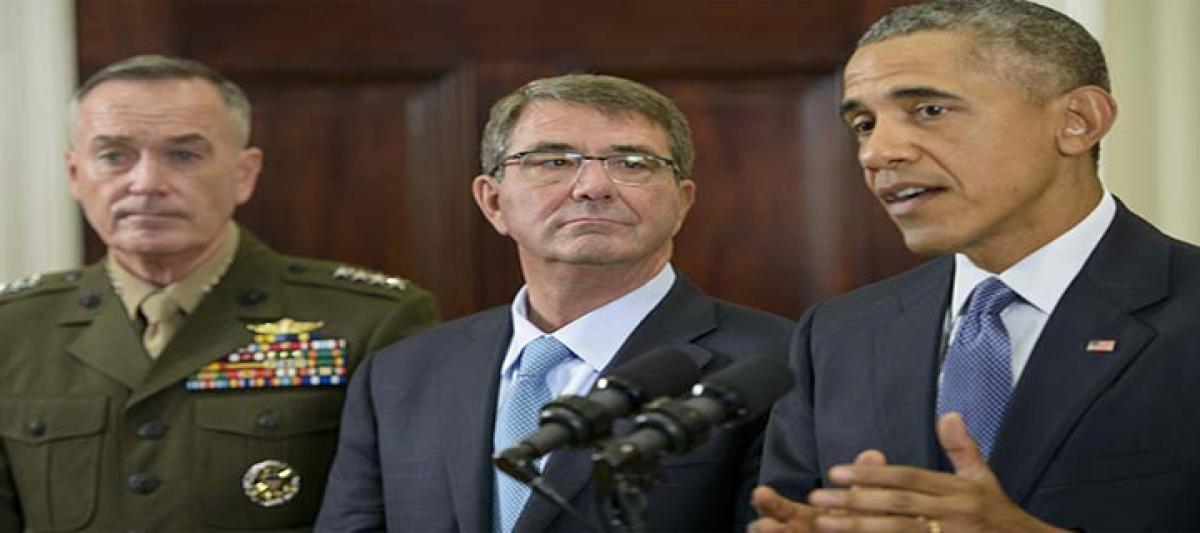Live
- CashKaro Founder Couple Swati & Rohan Bhargava Launch ‘BAD’ Podcast to Inspire India’s Next Generation of Dreamers
- Border-Gavaskar Trophy 2024-25: Australia’s assistant coach Daniel Vettori to miss first Test for IPL mega auction
- Maha polls: BJP’s ‘chota popat’ jibe in response to Congress ‘safe’ attack
- AM Green Kakinada Cluster Joins the World Economic Forum.
- 3 elephants electrocuted in Sambalpur
- Elevate Your Style: Handpicked Luxury Fashion & Accessories
- Ola Electric users continue to cry amid poor service, software glitches nationwide
- Panchayat Raj AE Panduranga Rao caught by ACB while taking a bribe of Rs 50,000.
- Leveraging Data and Analytics for Product Management Excellence: Mahesh Deshpande’s Approach
- Two vegetable varieties of Himachal varsity get national recognition
Just In

x
Highlights
The decision to keep thousands of US troops in Afghanistan drives home the hard truth that despite billions of dollars and years of training, Afghan security forces are far from ready to go it alone.
The decision to keep thousands of US troops in Afghanistan drives home the hard truth that despite billions of dollars and years of training, Afghan security forces are far from ready to go it alone.
.jpg)
But experts are divided on whether the troop levels outlined on Thursday by President Barack Obama are sufficient to prop up the weakling Afghan army.
Obama said 9,800 US troops would stay in Afghanistan until the end of next year, scrubbing plans to pull all but 1,000 from the country after 14 years of US involvement.
James Dobbins, a former US special envoy to Afghanistan and a veteran diplomat who is now a senior fellow at the Rand Corporation, said the plan was sufficient to maintain the status quo.
"Retaining the force at the current level will prevent the kind of collapse of order and disintegration of the country into a Syrian-type civil war," he said.
"It's adequate to do that. We have to anticipate the conflict's going to continue at more or less the current level for a while."
The US-led coalition officially ended its combat mission last year and the remaining troops are there to train and advise Afghan counterparts to police their own nation and to carry out counterterrorism operations.
Anthony Cordesman, of the Center for Strategic and International Studies, said 9,800 troops was a low number given the task involved.
By early 2017 when Obama steps down, their numbers are expected to drop to about 5,500.
"Can you cut well below 10,000? The answer is no you can't, not without crippling any real effort to do much more than hope to hold on to most of the major cities and urban population centers, and then gradually lose the countryside," Cordesman said.
"If you go down to 5,500 you are going to be way under a minimum level, and you have no real slack for forward combat advisers," he added.
'Cannot handle the fight'
The United States has spent more than $60 billion to train Afghan government troops and build their capacity since 2001. But their first year leading security efforts has been brutally hard.
Thousands have died, the Taliban has dealt them a string of blows and desertion rates are high. Plus the Islamic State group has emerged as a new threat in Afghanistan.
The Taliban launched a successful offensive in Helmand province this summer and went on to briefly capture the city of Kunduz. In both instances, Afghan security forces needed support from US-led trainers and aircraft to tilt the balance back in their favor.
"They cannot handle the fight alone in this stage of their development," General John Campbell, who heads the US-led NATO mission in Afghanistan, told US lawmakers last week.
The Afghan army lacks decent air capabilities to support troops on the ground, a crucial fighting element on rugged Afghan soil, Campbell noted.
So far it only has Russian Mi-17 helicopters and small MD-530 attack choppers, and still is waiting for 20 A-29 Super Tucano ground attack aircraft.
The planes are due to be supplied by the US Air Force, with deliveries beginning next year.
A rising toll
The death rate among Afghan forces has risen sharply, with 4,302 troops killed between January 1 and July 31, compared to 3,337 in the same time frame a year ago, according to figures from the United Nations mission in Afghanistan.
Adding to these woes, poor leadership and shoddy troop care have contributed to high desertion rates, and Campbell warned this was impacting combat readiness.
Still, Pentagon officials stress that despite these obstacles, Afghan soldiers are patriotic and want to fight for their country.
"Afghan forces have proven themselves to be capable and resilient fighters," Defense Secretary Ashton Carter told reporters Thursday.
"But Taliban advances in parts of the country underscore the reality that this is, and remains, a difficult fight," he added.
In addition to the US forces, thousands of additional foreign troops under the NATO mission in Afghanistan are expected to remain beyond 2016.
NATO Secretary General Jens Stoltenberg welcomed the US decision to keep troops in Afghanistan as part of a "crucial" effort to support Kabul.
Michael O'Hanlon, a senior fellow at The Brookings Institution, suggested Obama's plan allowed for sufficient troop numbers.
"But if not, at least we'll preserve the infrastructure to allow an increase quickly under the next president," he said.
More On

Next Story
More Stories
ADVERTISEMENT
© 2024 Hyderabad Media House Limited/The Hans India. All rights reserved. Powered by hocalwire.com







